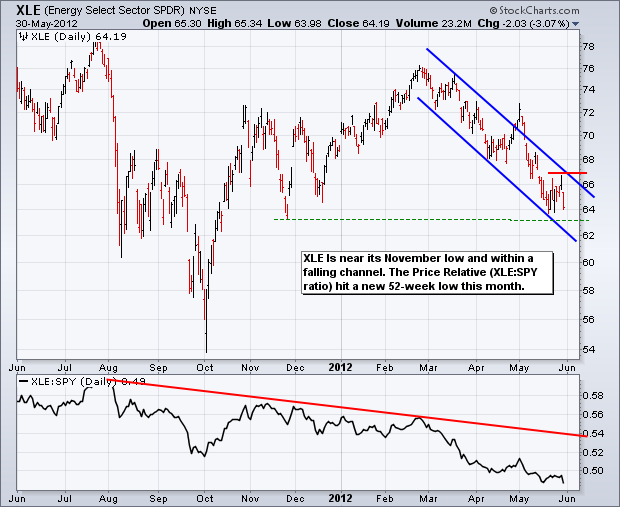Stocks were hit with concerns in Europe again on Wednesday. Once again, the market failed to put together back-to-back gains and failed to follow through on Tuesday's advance. All major index ETFs were down with small-caps leading the way. Large-cap techs held up relatively well as the Nasdaq 100 ETF (QQQ) declined less than 1%. All nine sectors were lower with the Energy SPDR (-3.07%) and the Finance SPDR (-2.33%) getting hammered. The defensive sectors held up the best as the Utilities SPDR (XLU), Consumer Staples SPDR (XLP) and Healthcare SPDR (XLV) declined less than .30%.
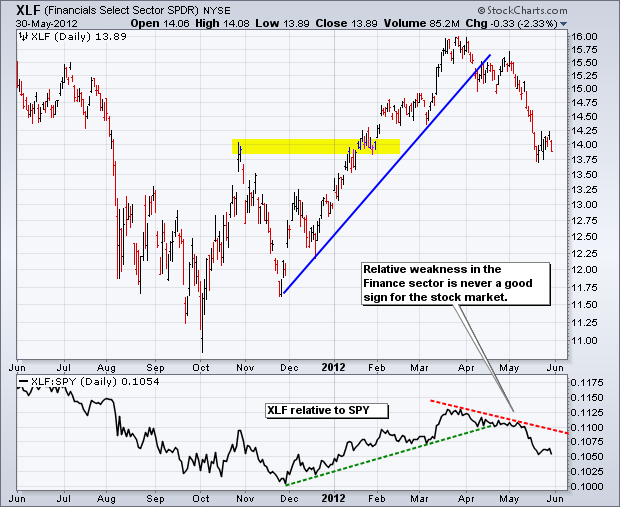
Spanish banks sparked the latest round of EU concerns. Even though direct US exposure to Spanish banks may be limited, indirect exposure is big enough for concern. The too-big-to-fail EU banks are exposed to Spain in a big way and the too-big-to-fail US banks are exposed to these big EU banks. Also note that the current recession in Europe is not helping the US, China or the world. As alluded to by Jim O'Neill of Goldmans Sach Asset Management in London, European problems can be solved with three simple steps. First, select on EU leader that speaks for the entire Eurozone at all meetings (G7, G8, G20 etc...). Two, agree to Eurobonds and link these to fiscal sustainability. Three, refinance and support all troubled Euro area banks. In short, O'Niell states that Europe should start acting as one economic and financial bloc. While this is certainly possible in 5-10 years, the chances of this happening in 2012 are slim and none. This is why money is seeking safe-havens in 10-year German Bunds and US Treasuries, which yield less than 2%. Both the German Bund Futures ETN (BUNL) and 7-10 year T-Bond ETF (IEF) hit fresh 52-week highs on Wednesday. New highs in these two suggest that the risk-off trade is alive and kicking.
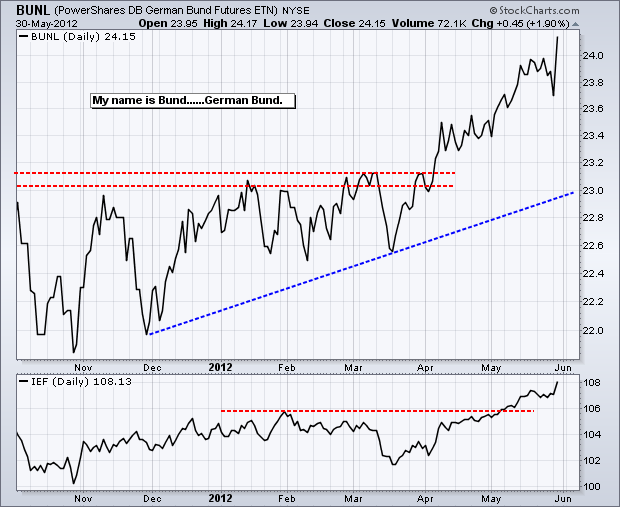
Volatility is the name of the game in US stocks right now. EU issues and a slew of economic reports are pushing around stocks this week. Is there any end in sight? In addition the EU issues, there are no fewer than 10 economic reports in the next two days. With the uptrend in volatility set to continue, it may be a good time to go fishing in an internet-free zone. On the 60-minute chart, the S&P 500 ETF (SPY) failed to hold its triangle breakout and gapped below first support at 132.50. Overall, a rising flag is taking shape and a break below flag support would signal a continuation of the May decline. RSI hit resistance at 60 and never turned bullish. The 5-day EMA of StochRSI moved below .50 to signal a downturn in short-term momentum.
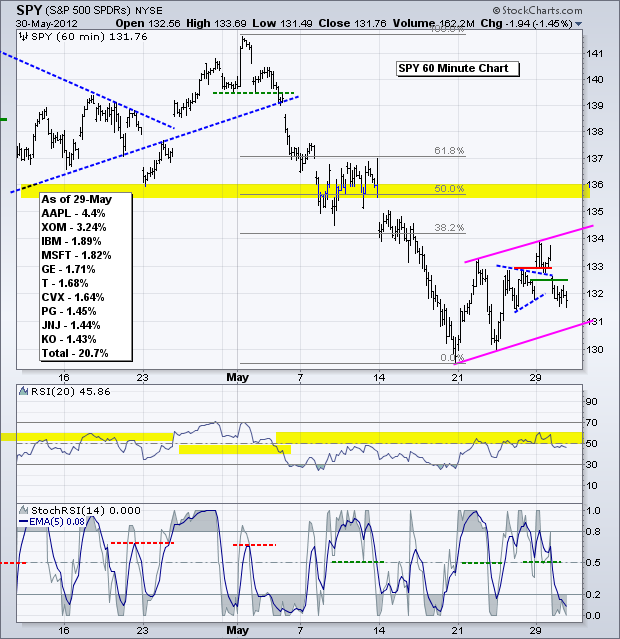
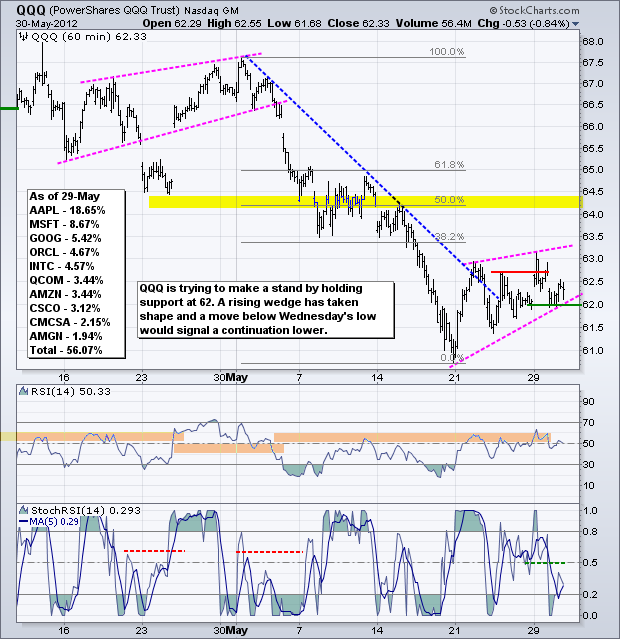
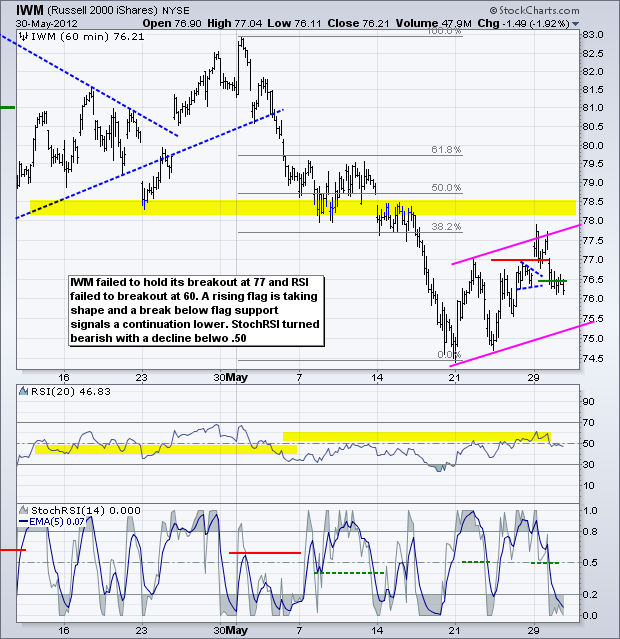
**************************************************************************
The 20+ Year T-Bond ETF (TLT) surged to a 52-week high with the move above 126. Treasuries held up because the Euro remained weak and Spanish equities crumbled - again. There is still demand for this key risk-off asset. Last week's lows mark first support at 122. The 10-year Treasury Yield ($TNX) moved to 1.625%, its lowest level in 60 years.
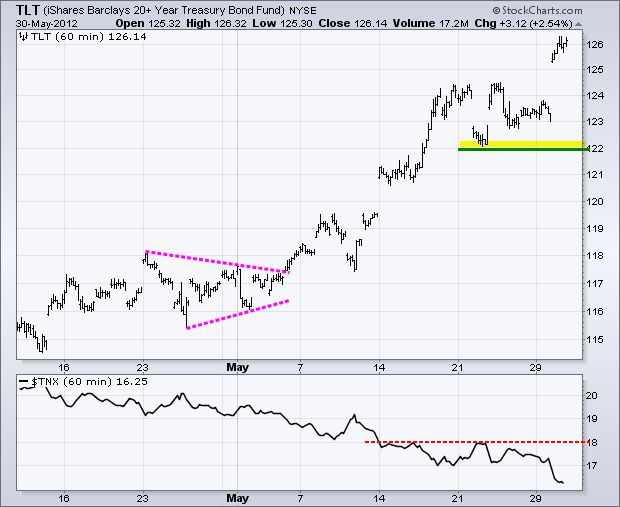
**************************************************************************
The US Dollar Fund (UUP) started strong and finished strong. UUP remains overbought and the Euro remains oversold, but Forex traders are not buying Euros because there is so much uncertainty on the horizon (Greece, Portugal and Spain). Broken resistance remains first support in the 22.55-22.6 area and key support remains at 22.40.
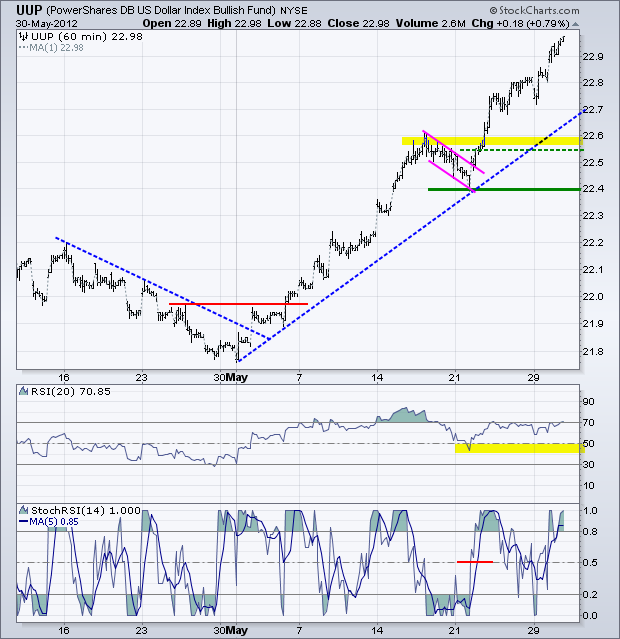
**************************************************************************
Falling oil prices will help consumers, but falling oil prices suggest weakness in oil demand and the economy. Oil is also being hit by a strong Dollar and weak stock market. The US Oil Fund (USO) broke flag support and closed at its lowest level since mid October. Overall, USO is down over 15% this month and showing no signs of a rebound, despite being massively oversold.
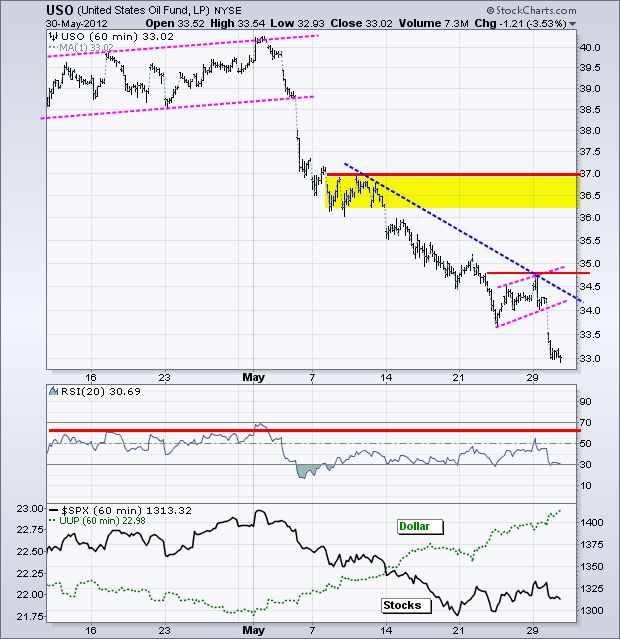
**************************************************************************
Gold started the day weak, but quickly recovered with a fairly strong bounce off support from the May lows. This is, however, support in a downtrend and the odds favor a support break when the trend is down. Also note that a descending triangle could be taking shape and a break below the May lows would target a move to 143. The height of the pattern (155 – 149 = 6) is subtracted from the break for a target. I am going on a limb and moving key resistance to 154. A break above 54 in GLD and 60 in 40-period RSI would reverse the short-term downtrend in GLD.
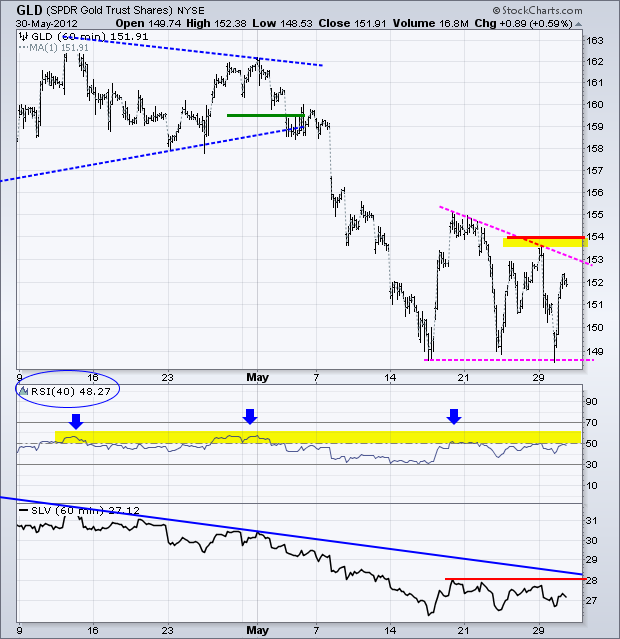
**************************************************************************
Key Economic Reports:
Thu - May 31 - 07:30 - Challenger Job Cut Report
Thu - May 31 - 08:15 - ADP Employment Report
Thu - May 31 - 08:30 - Jobless Claims
Thu - May 31 - 08:30 - GDP
Thu - May 31 - 09:45 - Chicago PMI
Thu - May 31 - 11:00 - Oil Inventories
Fri - Jun 01 - 08:30 - Employment Report
Fri - Jun 01 - 10:00 - ISM Manufacturing Index
Fri - Jun 01 - 10:00 - Construction Spending
Fri - Jun 01 - 14:00 - Auto/Truck Sales
Sun - Jun 04 - 10:00 – Greek Holiday
Sun - Jun 17 - 10:00 – Greek Elections
Sun - Jun 28 - 10:00 – 2-day EU Summit
Charts of Interest: Gone fishing until Tuesday ....
This commentary and charts-of-interest are designed to stimulate thinking. This analysis is not a recommendation to buy, sell, hold or sell short any security (stock ETF or otherwise). We all need to think for ourselves when it comes to trading our own accounts. First, it is the only way to really learn. Second, we are the only ones responsible for our decisions. Think of these charts as food for further analysis. Before making a trade, it is important to have a plan. Plan the trade and trade the plan. Among other things, this includes setting a trigger level, a target area and a stop-loss level. It is also important to plan for three possible price movements: advance, decline or sideways. Have a plan for all three scenarios BEFORE making the trade. Consider possible holding times. And finally, look at overall market conditions and sector/industry performance.

About the author:
Arthur Hill, CMT, is the Chief Technical Strategist at TrendInvestorPro.com. Focusing predominantly on US equities and ETFs, his systematic approach of identifying trend, finding signals within the trend, and setting key price levels has made him an esteemed market technician. Arthur has written articles for numerous financial publications including Barrons and Stocks & Commodities Magazine. In addition to his Chartered Market Technician (CMT) designation, he holds an MBA from the Cass Business School at City University in London.
Learn More
